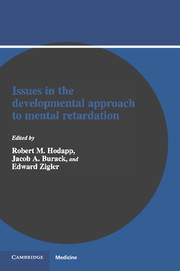Book contents
- Frontmatter
- Contents
- Preface
- Contributors
- Part 1 Developmental theory
- Part 2 Applying developmental theory to different types of retarded individuals
- 7 Cultural–familial mental retardation: A developmental perspective on cognitive performance and “helpless” behavior
- 8 The organization and coherence of developmental processes in infants and children with Down syndrome
- 9 Developmental issues in fragile X syndrome
- 10 Deviance and developmental approaches in the study of, autism
- 11 The issues of multiple pathways in the development of handicapped children
- 12 Summing up and going forward: New directions in the developmental approach to mental retardation
- Author index
- Subject index
9 - Developmental issues in fragile X syndrome
from Part 2 - Applying developmental theory to different types of retarded individuals
Published online by Cambridge University Press: 07 September 2010
- Frontmatter
- Contents
- Preface
- Contributors
- Part 1 Developmental theory
- Part 2 Applying developmental theory to different types of retarded individuals
- 7 Cultural–familial mental retardation: A developmental perspective on cognitive performance and “helpless” behavior
- 8 The organization and coherence of developmental processes in infants and children with Down syndrome
- 9 Developmental issues in fragile X syndrome
- 10 Deviance and developmental approaches in the study of, autism
- 11 The issues of multiple pathways in the development of handicapped children
- 12 Summing up and going forward: New directions in the developmental approach to mental retardation
- Author index
- Subject index
Summary
Fragile X syndrome is a recently identified X-linked disorder resulting in mental retardation and characteristic physical, cognitive, and behavioral features. Although data are now accumulating regarding the psychological functioning of fragile X males, previous research has focused almost exclusively on the genetic aspects and physical features of the disorder. As a result, the data are quite limited on the intellectual, adaptive, and behavioral functioning of boys and men with fragile X syndrome, and many questions remain about the development of fragile X males in virtually all areas of functioning.
In addition, the research reports on fragile X syndrome are found largely in the genetics literature, and less accessible to parents, educators, and health professionals who seek guidance with the daily management and education of these individuals. Given this need, and the relative newness of the disorder, this chapter will begin with a brief overview of fragile X syndrome, including its genetic features and enigmas and its physical phenotype. Data on the prevalence of fragile X syndrome, and the intellectual, adaptive, and behavioral functioning of fragile X males will then be presented. These findings will be discussed in relation to the two-group approach in mental retardation, the trajectory of intelligence, and the interplay between genetics and the environment.
Overview of fragile X syndrome
Genetic features
The chromosomal abnormality associated with fragile X syndrome was initially identified in 1969 by Lubs, who observed a pinched or constricted end on the X chromosomes of mentally retarded males in a large pedigree that followed an X-linked inheritance pattern.
- Type
- Chapter
- Information
- Issues in the Developmental Approach to Mental Retardation , pp. 226 - 245Publisher: Cambridge University PressPrint publication year: 1990
- 15
- Cited by



